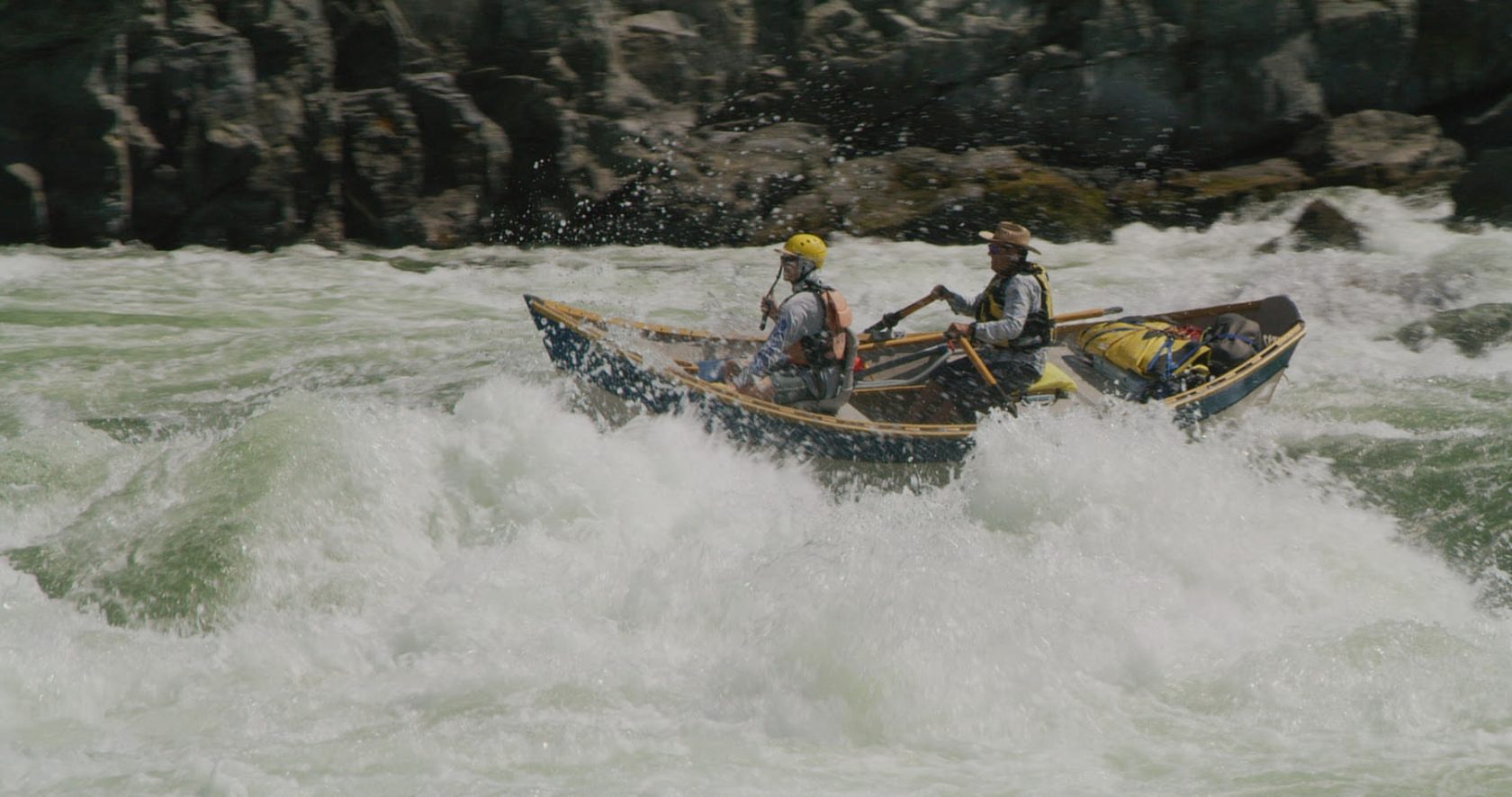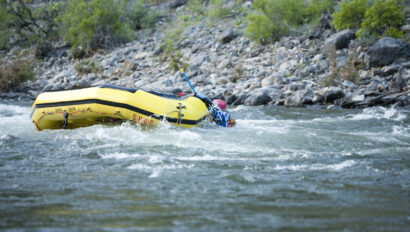10 of Idaho’s Best Whitewater Rapids


The Top Idaho Rapids According to River Guides
We admit it’s pretty tough to pick the best whitewater rapids in Idaho. This is the “whitewater state” we’re talking about after all. But when it comes to narrowing down the choices, river guides definitely have their favorites. We asked around and here are the rapids that guides love to paddle and row that offer some of the best river rafting and boating in Idaho.

1) Wild Sheep | Snake River through Hells Canyon
Rating: Class IV (depending on water level)
Rumors of Hells Canyon, the deepest gorge in North America, is what first brought whitewater enthusiasts to Idaho. While many of the original big drops now lie under the reservoir made by Hells Canyon Dam, several big rapids on the Snake River still remain. Among the most notorious are Granite and Wild Sheep. At certain flows, Granite’s Green Room—an ocean-sized wave where at the bottom of the trough your boat is surrounded on all sides by green water—appears and is a favorite among boaters. But the real challenge to guides on this stretch is Wild Sheep, the first large rapid on a Hells Canyon trip.
“There are very few rapids that keep me up the night before a trip,” says Mia Clyatt, an OARS Idaho guide. “But if I’m sleeping at the dam and it’s high water, I’m thinking about Wild Sheep, and I’m losing sleep about that rapid.”
At high water, boats take a pushy right line with a couple massive holes and some haphazard laterals that can easily flip boats. During lower water, the line moves to the left side, requiring a solid left-to-right move into a series of large waves. If it doesn’t go well, boats have to be righted quickly before more whitewater.
2) Ruby Rapid | Riggins Section of the Salmon River
Rating: Class III
For most of the season, Ruby Rapid—named for Idaho’s famed star garnets—is a mellow, Class II ride. But at high water, it’s a Class IV monster. During spring runoff, Ruby pushes the entire current of the Salmon River (sometimes as high as 90,000 cubic feet per second) against a sheer granite cliff face. At the entrance, you have to make it through the laterals nicknamed “the pencil sharpener” before working your boat to the right as you crest ocean-sized rollers. Miss this move and you’ll end up in the “pancake wave” that will flip you like the breakfast hotcake that you are. Plus, you’ll have an audience. The nearby Salmon River road makes this a favorite spot to cheer on boats as they take on Ruby, especially during Riggins’ Big Water Blowout event.

3) Black Creek | Main Salmon River
Rating: Class IV
Black Creek Rapid is the quintessential pool-drop-river rapid. Nestled in the heart of jaw-dropping Black Canyon on the Main Salmon, it’s also one of Idaho’s newest rapids (formed in 2011 by a creek blowout). At high water, Black Creek becomes giant, roller coaster-sized waves. As the water drops, however, the rapid becomes more technical. Most boaters choose the slender left line rather than risk a center run, push away move from three giant, back-to-back hydraulics. Not to say the left line is anything to sneeze at – a combination of lateral waves makes finding the proper entrance point crucial to not sticking your boat on the sharp left hand side rocks. “It’s a rapid that comes with a lot of myth and rumor,” says Clyatt. “It’s a pretty intimidating looking line and there are a lot of rocks along the left shore that you could smash in a dory.”
4) Slide | Lower Salmon River
Rating: Class V (depending on water level)
Most boaters slip through Slide Rapid without even knowing it is named…at low water. At high water, Slide Rapid becomes a Class V+ rapid that prevents most commercial companies from running this section of the river. Hit river conditions at just the right medium flow, however, and Slide becomes what river legends are made of.
“It prevents trips from launching, flips J rigs, and it leaves a heavy knot in your stomach that feels kind of like too much Taco Bell,” according to Idaho guide Ian Fodor-Davis.
Created by rock fall from a nearby power line, Slide, like many rapids, is created by constriction. Unlike other rapids though, Slide has all 415 miles of Salmon River flow behind it. Two gigantic lateral waves come together into a froth of eddy lines and surging hydraulics. Hold your breath! Or, wait for a lower water Gorges of the Lower Salmon trip and live vicariously through three OARS guides who took on Slide Rapid in whitewater kayaks.
5) Ladle | Selway River
Rating: Class IV+
The Selway is known for its wilderness character, exceptional fishing and beautiful cedar-lined views. It’s also known for its meaty, technical rapids like Ladle.
“Ladle is one of those rapids where you get out to scout and you’re like, ‘Whaaaaaa?!’ because it is the mother of all boulder gardens,” explains OARS guide Jasmine Wilhelm.
Ladle starts wide as you drop in, but then it funnels to a constriction at the bottom. “The first time I ran it the water was really low and we had small boats so we snuck far left,” Wilhelm recalls. “It was a move of total blind faith because you couldn’t see what you’re about to encounter as you made a 90-degree sweeping right turn around these massive boulders.”
“But it’s beautiful to be in that channel making tight moves as the water just rages through the boulder garden to your right like it’s running through a colander,” she continues. “Ladle had this sense of wildness about it.”
6) Hells Half Mile | Middle Fork Salmon River
Rating: Class IV
The stunning Middle Fork of the Salmon River, which runs through the heart of the Frank Church Wilderness, is famed for having 100 rapids in 100 miles, and Hells Half Mile is one of the best. It’s not the famous “big drop” you might know from the similarly-named rapid on the Green River in Utah, but it’s equally as challenging, according to OARS trip leader and Idaho guide Ashley Brown.
“At high water, Hells Half Mile is a long, continuous S-bend ending in a narrow canyon that hides some boat-eating holes,” describes Brown. “At low water, that long S-bend turns into a boulder garden that will leave you either exalted or exasperated.” In fact, at low flows it becomes so technical that it pushes trip launches down to Indian Creek, letting the guides brave the rocks and shallows with empty boats.
Beyond the excitement though, the narrows at the bottom of the rapid make it one of the most aesthetically pleasing rapids in the West. And as the first major rapid on the Middle Fork, it’s the perfect teaser of what’s to come.

7) Flight Simulator | East Fork of the South Fork of the Salmon
Rating: Class V+
This complex gauntlet sits at the top of the ultra-classic East Fork of the South Fork run, so paddlers who aren’t feeling it can join the crew below and still have a great day, according to Idaho guide Dan Thurber. For better or worse, the crux is the entrance.
“It’s a dizzyingly long rapid with sustained Class IV-V whitewater that stretches around six bends in the river. Or is it 7? I can never remember, especially when I’m in the middle of it,” explains Idaho guide Dan Thurber. “It’s impossible to memorize every feature and move, so it forces paddlers to think more about big ideas: Keep your eyes open, follow seams and waves, hug the inside of corners, remember to breathe. And for God’s sake: don’t swim!”
8) Termination | Lochsa River
Rating: Class III-IV (depending on water level)
Super beautiful and easily accessed along scenic Highway 12, the Lochsa River is known for being “explosive, continuous and high adventure.” Running during peak flows in the spring, the Lochsa draws boaters from across the West. While most whitewater love goes to iconic Lochsa Falls a few miles upstream, another not-to-be-missed crowd favorite is Termination. Giant entrance waves followed by a pancake slapper lateral from the left has had adventure seekers swimming downstream without a paddle more than once. Whether you stay in the boat or not, it’s guaranteed to be a cold but exciting ride.

9) Blackadar | South Fork of the Payette River
Rating: Class IV
Three high adventure sections of whitewater within twenty minutes of each other make the Payette River a whitewater utopia. And while it’s not the biggest rapid on the South Fork Payette, Blackadar Rapid, right after the portage for Big Falls, makes the best list for being big on fun and scenery.
It’s “about as close to wilderness as you can find on a day stretch in Idaho,” explains Payette River guide Chelsea Galleri. “It feels deep and remote and everyone’s hearts are pounding after having to move boats and people around a giant waterfall!”
Named after Idaho whitewater pioneer and wilderness advocate Walt Blackadar, this relatively forgiving Class IV drop surprises paddlers with a few big hits at the end.
10) Sunbeam | Upper Salmon River
Rating: Class III-IV (depending on water level)
In 1910, a dam was constructed across the Salmon River to create water pressure for mines along the Yankee Fork tributary. After sportsmen and Idaho Fish and Game realized the dam was reducing Sockeye Salmon, the dam was blasted. What remains—Sunbeam Rapid—is a site to behold (as are its waves).
“It’s a unique rapid because as you enter, your bow is angled upstream” says Stanley-area guide Casey Jones. “You can’t see the hydraulics until you come around the corner. If you think you’re going to drive your boat across the current, you’ll fail. You have to run this rapid tight and upper right.”
And if you blow your line, according to Jones, it’s a huge hit and full-on swim through frothing post-dynamite rebar/concrete waves. Many guides consider it to be one of the most technical and iconic rapids on the Salmon River.
Got an Idaho whitewater favorite? Let us know in the comments.
* Originally published in 2016 and last updated October, 2023
Related Posts
Sign up for Our Newsletter



